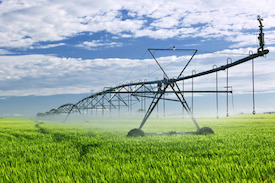Agriculture uses an estimated 70% of the freshwater withdrawals globally and 40% of freshwater withdrawals in the United States. With severe droughts, shrinking reservoirs, and freshwater shortages in some areas of the US, water conservation is as important as ever for farmers. Here are 10 water conservation ideas that can minimize water waste.
 Control Phreatophytes
Control Phreatophytes
Phreatophytes are plants such as the Russian Olive, tamarisk, willows, and cottonwood. According to Colorado State University’s website: “phreatophytes can consume significant quantities of water through evapotranspiration, reducing the availability of water to a cropping system and its users.” These plants can be reduced or removed through a variety of methods including chemical or mechanical.
Low-Energy Spray Irrigation
The US Geological Survey suggests using a Low Energy Precision Application (LEPA) center-pivot system to gently spray water very close to the ground. This method can increase irrigation efficiency from 60% (for traditional spray irrigation) to over 90%.
Irrigation Scheduling
Scheduling irrigation based on soil-plant or atmosphere measurements can decrease water use while improving yields. Software programs can collect weather data including local temperature, rainfall, humidity, and crop evapotransporation to provide recommendations for optimal irrigation scheduling. The University of Minnesota provides an extensive guide on irrigation scheduling using the checkbook method.
Drip Irrigation
According to Big Picture Agriculture, “drip irrigation conserves 50 to 70 percent more water than traditional methods while increasing crop production by 20 to 90 percent.” Colorado State University‘s website explains that drip irrigation provides a desirable balance of water and air in the soil that promotes plant growth while minimizing runoff and evaporation.
Black Polyethylene Plastic Film
Laying black polyethylene plastic film around certain crops will prevent surface evaporation, control weeds, and keep the soil warm at night. This can save 25 percent in water requirements. Black polyethylene film of 1 to 1.5 millimeters in thickness is adequate although it may need to be replaced after one season.
Laser Leveling
Using laser-controlled land leveling equipment can ensure the fields are the ideal slope depending on the type of irrigation used. According to the Texas Water Development Board: “With sprinkler systems, a perfectly level field conserves water by reducing runoff, allowing uniform distribution of water. Furrow irrigation systems need a slight but uniform slope to use water most efficiently. Laser leveling can reduce water use by 20-30% and increase crop yields by 10-20%.”
Rainwater Catchment from a High Tunnel
Iowa State University’s website describes how to install a catchment system to collect rainwater. A 30 by 96 foot hoop house can collect up to 28,000 gallons of water per season and a 1/2 inch of rainfall can fill two 500 gallon tanks.
Use a Water Flow Meter to Measure Water Usage
Peter Drucker famously said “what gets measured, gets managed.” Monitoring how much water is being used in real time with water flow meters can help farmers determine irrigation efficiency and improve water management.
Tailwater Return Systems
Tailwater return systems catch runoff at the low end of the field and pumps it back to the top of the field for reuse. This system may include ditches to collect the runoff, waterways to convey water to a central area, a reservoir, a pump, a power unit, and a pipeline. You can view a diagram of a tailwater return system here.
Improved Furrows
The California Department of Water Resources cites improved furrows as a recommended water conservation method and the University of Nebraska website states that firming irrigation furrows can improve irrigation performance. According to a UNL report, “if the infiltration rate is reduced, then additional water is available to advance further down the furrow. The result is faster advance time to the end of the field, improved water distribution and decreased potential for deep percolation at the head end of the field.”
If you have another farm water conservation tip, please share it below in the comments.
